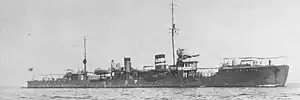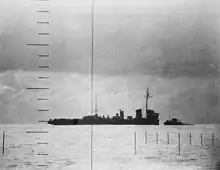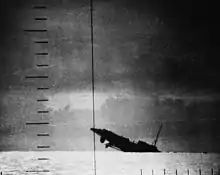Momi-class destroyer
The Momi-class destroyers were a class of twenty-one second-class destroyers of the Imperial Japanese Navy.[1] All were named for plants. Obsolete by the beginning of the Pacific War, the Momis were relegated to mostly secondary roles, with some vessels serving throughout the war as patrol vessels or high speed transports.
 Ashi | |
| Class overview | |
|---|---|
| Name | Momi class |
| Builders | |
| Operators | |
| Preceded by | Kawakaze class |
| Succeeded by | Minekaze class |
| Built | 1918–1923 |
| In commission | 1919–1946 |
| Planned | 28 |
| Completed | 21 |
| Cancelled | 7 |
| Lost | 11 |
| Scrapped | 10 |
| General characteristics as built | |
| Type | Destroyer |
| Displacement |
|
| Length | |
| Beam | 7.9 m (26 ft) |
| Draft | 2.4 m (8 ft) |
| Installed power |
|
| Propulsion | 2 shafts; 2 × Parsons steam turbines |
| Speed | 36 knots (67 km/h; 41 mph) |
| Range | 3,000 nmi (5,600 km; 3,500 mi) at 15 knots (28 km/h; 17 mph) |
| Complement | 148 |
| Armament |
|
Background
Construction of the medium-sized Momi-class destroyers was authorized as part of the Imperial Japanese Navy's 8-4 Fleet Program from fiscal 1918–1920, as an accompaniment to the larger Minekaze class with which they shared many common design characteristics.[2] These vessels were produced at several shipyards around Japan, and when formed into attack squadrons of two to four vessels, made up the backbone of the inter-war Imperial Japanese Navy.[3]
The final seven vessels planned for this series were cancelled, and re-ordered as the new Wakatake-class destroyers in 1919, and by the mid-1920s the concept of the "second-class destroyer" had fallen out of favor due to the greater capabilities offered by the new generation of fleet destroyers.[4]
Initial design
The Momi class was a development of the Enoki second-class destroyers, relying on the same basic hull. They were quite small, comparable to Royal Navy corvettes. The design incorporated features discovered on German destroyers awarded as reparations from World War I, including a lengthened forecastle with a break forming a well deck immediately forward of the bridge, and a front gun battery placed on a pedestal on the centerline so that it could be operated in heavy weather. This arrangement also offered the advantage of a low, semi protected area for the forward torpedo tubes albeit at the cost of becoming awash in heavy seas.[5] Initial problems with stability during high-speed turns were later corrected by widening the beam and bringing up the waterline.
When compared with the Minekaze class, the smaller size necessitated a reduction from four boilers to three and the adoption of lighter-weight Parsons direct-drive turbines, resulting in a drop from 38,500 hp in the Minekaze class to 21,500 hp (16,000 kW) in the Momi class. In addition, fuel capacity was lowered to 275 tons of oil fuel.
As gear turbine technology was not yet perfected, the navy experimented with a variety of power plants on the Momi class:
| Turbines | Equipment for |
|---|---|
| Brown-Curtis turbines | Kaya, Warabi and Tade |
| Parsons impulse turbines | Hishi and Hasu |
| Escher Wyss & Cie Zoelly turbines | Sumire |
| Mitsubishi Shipbuilding High-pressure impulse turbine and low-pressure reaction turbine |
Kaki |
| Kampon turbines | all others |
The Momi class was heavily armed for its small displacement, with a main battery of Type 3 120 mm 45 caliber naval guns, the same as was used on the Minekaze-class, and a set of double torpedo launchers. Anti-aircraft protection was provided by two 7.7mm machine guns.[4]
Early operational history
Due to their shallow draft, the Momi-class destroyers proved to be excellent for operation in coastal waters, and were used along the coast of China to support amphibious landings during the Second Sino-Japanese War.
A number of the Momi-class vessels were lost or disposed during the interwar period. Momi herself was turned over to trials in 1932, while Warabi was run down by the cruiser Jintsu on 27 August 1927 off Maizuru, Kyoto. Kaya and Nashi were scrapped in 1939.[4]
Also in 1939, Aoi, Fuji, Hagi, Hishi, Kiku, Satsuki, Tade, Tsuta and Yomogi were removed from front line combat service and converted into patrol vessels. In 1940, Ashi, Kaki, Nine, Sumire, and Take were disarmed, and re-rated as training ships.[4]
By the time of the Pacific War, the Momi-class was reaching the end of its service life, and only three (Tsuga, Hasu and Kuri) remained in service as destroyers. An effort was made to upgrade their capabilities by removing the minesweeping gear from the stern and replacing with 36 to 48 depth charges and four depth charge launchers. The amidships Type 3 guns was replaced by two triple Type 96 AA guns from 1942 to 1943, and a Type 13 radar was added. Tsuga was sunk by air attack 15 January 1945. Hasu was surrendered and scrapped at the end of the war. Kuri was surrendered, but sank after striking a mine off Korea on 8 October 1945.[4]
As patrol boats


Beginning in 1939, nine Momi-class vessels were re-classified as patrol boats and converted for escort duty, having one boiler removed (dropping their power to 12,000 ihp (8,900 kW) and speed to just 18 knots (21 mph; 33 km/h). Their torpedo tubes, minesweeping gear, and the amidships Type 3 gun mount were replaced by six Type 96 25 mm AT/AA Guns, 36 depth charges, and three depth charge throwers.[4] As well, their names were dropped and they were simply numbered.
During 1941–1942, these vessels were modified again, to carry and launch a Toku Daihatsu-class landing craft, by having the aft smokestack removed and the stern modified with a sloping deck to the waterline, as well as providing accommodation for 150 naval infantry troops. All of these vessels except ex-Fuji (as Patrol Boat #36) were sunk during the course of the Pacific War.[4]
List of ships
| Name | Kanji | Builder | Laid down | Launched | Completed | Fate |
|---|---|---|---|---|---|---|
| Momi | 樅 | Yokosuka Naval Arsenal, Japan | 23 January 1918 | 10 June 1919 | 27 December 1919 | Decommissioned, 1 April 1932; renamed Disposal Destroyer No.2 (廃駆二号, Haiku 2-Gō); used for trials to 1936 |
| Kaya | 榧 | 23 December 1918 | 10 June 1919 | 28 March 1920 | Decommissioned, 1 February 1940 and scrapped | |
| Nashi | 梨 | Kawasaki Shipyards, Kobe, Japan | 2 February 1918 | 26 August 1919 | 10 December 1919 | |
| Take | 竹 | Kawasaki Shipyards, Kobe, Japan | 2 December 1918 | 26 August 1919 | 25 December 1919 | Decommissioned, 1 February 1940; converted to training ship; scuttled as breakwater at Akita port in 1948 |
| Kaki | 柿 | Uraga Dock Company, Japan | 27 February 1919 | 20 October 1919 | 2 August 1920 | Decommissioned, 1 April 1940; converted to training ship; re-converted to auxiliary ship Ōsu (大須) 23 February 1945; scrapped 1948 |
| Tsuga | 栂 | Ishikawajima Shipyards, Japan | 5 March 1919 | 17 April 1920 | 20 June 1920 | Sunk off Taiwan, 15 January 1945, in air attack; struck 10 March 1945 |
| Nire | 楡 | Kure Naval Arsenal, Japan | 5 September 1919 | 22 December 1919 | 31 March 1920 | Decommissioned, 1 February 1940; converted to training ship, re-converted to auxiliary ship No.1 Tomariura (第一泊浦, Dai-1 Tomariura) 15 December 1944; scrapped 1948 |
| Kuri | 栗 | Kure Naval Arsenal, Japan | 5 December 1919 | 19 March 1920 | 30 April 1920 | Mined off Pusan, 8 October 1945; struck 25 October 1945 |
| Kiku | 菊 | Kawasaki Shipyards, Kobe, Japan | 20 January 1920 | 13 October 1920 | 10 December 1920 | Converted to Patrol Boat No.31 (第三十一号哨戒艇, Dai-31-Gō shōkaitei) 1 April 1940; sunk at Palau, 30 March 1944 by air attack; struck 10 May 1944 |
| Aoi | 葵 | Kawasaki Shipyards, Kobe, Japan | 1 April 1920 | 9 November 1920 | 10 December 1920 | Converted to Patrol Boat No.32 (第三十二号哨戒艇, Dai-32-Gō shōkaitei) 1 April 1940; grounded 23 December 1941 at Wake Island; struck 15 January 1942 |
| Hagi | 萩 | Uraga Dock Company, Japan | 28 February 1920 | 29 October 1920 | 20 April 1921 | Converted to Patrol Boat No.33 (第三十三号哨戒艇, Dai-33-Gō shōkaitei) 1 April 1940; grounded 23 December 1941 at Wake Island; struck 15 January 1942 |
| Fuji | 藤 | Fujinagata Shipyards, Japan | 6 December 1919 | 27 November 1920 | 31 May 1921 | Converted to Patrol Boat No.36 (第三十六号哨戒艇, Dai-36-Gō shōkaitei) 1 April 1940; surrendered to Netherlands in July 1946 at Surabaya; scrapped 10 August 1946 |
| Susuki | 薄 | Ishikawajima Shipyards, Japan | 3 May 1920 | 21 February 1921 | 25 May 1921 | Converted to Patrol Boat No.34 (第三十四号哨戒艇, Dai-34-Gō shōkaitei) 1 April 1940; sunk 6 March 1943 in collision with Yakaze off Kavien; written off 10 January 1945. |
| Hishi | 菱 | Uraga Dock Company, Japan | 10 November 1920 | 9 May 1921 | 23 March 1922 | Converted to Patrol Boat No.37 (第三十七号哨戒艇, Dai-37-Gō shōkaitei) 1 April 1940; sunk off Borneo, by USS Pope 24 January 1942; struck 10 April 1942 |
| Hasu | 蓮 | Uraga Dock Company, Japan | 2 March 1921 | 8 December 1921 | 31 July 1922 | Retired, 12 October 1945; scuttled as breakwater in Fukui, 1946 |
| Warabi | 蕨 | Fujinagata Shipyards, Japan | 12 October 1920 | 28 September 1921 | 19 December 1921 | Sunk 24 August 1927 in collision with Jintsu off Cape Miho; struck 15 September 1927 |
| Tade | 蓼 | Fujinagata Shipyards, Japan | 20 December 1920 | 15 March 1921 | 31 July 1922 | Converted to Patrol Boat No.39 (第三十九号哨戒艇, Dai-39-Gō shōkaitei) 1 April 1940; torpedoed off Yonaguni by USS Seawolf (SS-197) 23 April 1943; struck 1 July 1943 |
| Sumire | 菫 | Ishikawajima Shipyards, Japan | 24 November 1920 | 14 December 1921 | 31 March 1923 | Decommissioned, 1 February 1940; converted to training ship, re-converted to auxiliary ship Mitaka (三高) 23 February 1945; scrapped 1948 |
| Tsuta | 蔦 | Kawasaki Shipyards, Kobe, Japan | 16 October 1920 | 9 May 1921 | 30 June 1921 | Converted to Patrol Boat No.35 (第三十五号哨戒艇, Dai-35-Gō shōkaitei) 1 April 1940; sunk at Lae by air attack 2 September 1942; struck 10 February 1943 |
| Ashi | 葦 | Kawasaki Shipyards, Kobe, Japan | 15 November 1920 | 3 September 1921 | 29 October 1921 | Decommissioned, 1 February 1940; converted to training ship, re-converted to auxiliary ship No.2 Tomariura (第二泊浦, Dai-2 Tomariura) 15 December 1944; modified to Shin'yō suicide motorboatt mothership 1945, scrapped 1947 |
| Yomogi | 蓬 | Ishikawajima Shipyards, Japan | 26 February 1921 | 14 March 1922 | 19 August 1922 | Converted to Patrol Boat No.38 (第三十八号哨戒艇, Dai-38-Gō shōkaitei) 1 April 1940: torpedoed Bashi Strait by USS Atule 25 November 1944; struck 10 March 1945 |
Notes
- Jentsura, Warships of the Imperial Japanese Navy, 1869-1945
- Howarth, The Fighting Ships of the Rising Sun
- Globalsecurity.org, IJN Momi class destroyers
- Stille, Mark (2017). Imperial Japanese Navy Antisubmarine Escorts 1941–45. Oxford, UK: Osprey Publishing. pp. 12–14. ISBN 978-1-4728-1817-1.
- Destroyers of World War Two: An International Encyclopedia. pp. 188/189
References
- Gardiner, Robert & Gray, Randal, eds. (1985). Conway's All the World's Fighting Ships 1906–1921. Annapolis, Maryland: Naval Institute Press. ISBN 0-85177-245-5.
- Evans, David (1979). Kaigun: Strategy, Tactics, and Technology in the Imperial Japanese Navy, 1887-1941. US Naval Institute Press. ISBN 0-87021-192-7.
- Howarth, Stephen (1983). The Fighting Ships of the Rising Sun: The Drama of the Imperial Japanese Navy, 1895–1945. Atheneum. ISBN 0-689-11402-8.
- Jentschura, Hansgeorg; Jung, Dieter & Mickel, Peter (1977). Warships of the Imperial Japanese Navy, 1869–1945. Annapolis, Maryland: United States Naval Institute. ISBN 0-87021-893-X.
- Watts, Anthony J. & Gordon, Brian G. (1971). The Imperial Japanese Navy. Garden City, New York: Doubleday. ISBN 0385012683.